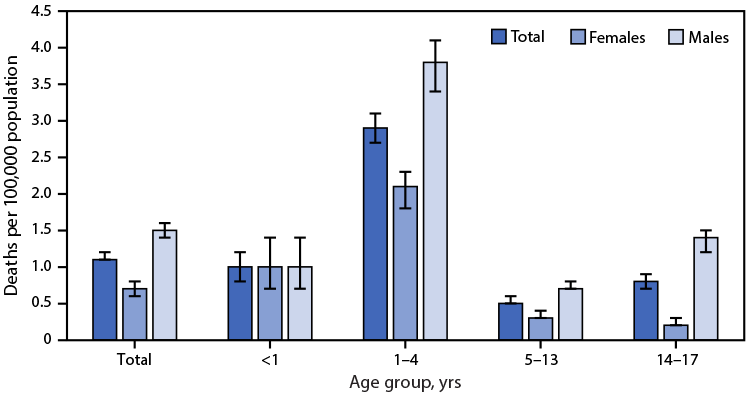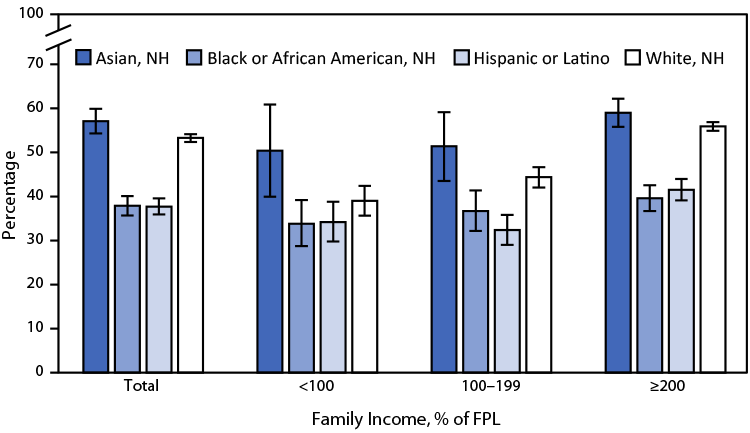NCHS: A Blog of the National Center for Health Statistics
Understanding Fertility and Families for 50 Years

The National Survey of Family Growth is celebrating its 50th year anniversary in 2023. This survey, administered by NCHS, provides a comprehensive, nationally representative snapshot of topics related to fertility, family formation, and reproductive health in the United States. The National Survey of Family Growth’s core purpose has been to explain U.S. birth rates by Read More >
Posted on byQuickStats: Percentage of Children and Adolescents Aged 4–17 Years Who Practiced Yoga During the Past 12 Months, by Sex and Age Group — National Health Interview Survey, United States, 2022

In 2022, 12.3% of children and adolescents aged 4–17 years had practiced yoga in the past 12 months. Children and adolescents aged 4–11 years were more likely to have practiced yoga than those aged 12–17 years (14.7% versus 9.2%). The declining percentages with age were found for both males and females: 10.4% versus 5.3% among Read More >
Posted on byQuickStats: Percentage of Adults Aged ≥18 Years Who Felt Very Tired or Exhausted Most Days or Every Day in the Past 3 Months, by Sex and Age Group — National Health Interview Survey, United States, 2022

In 2022, 13.5% of adults aged 18 and older felt very tired or exhausted most days or every day in the past 3 months, and this percentage declined with age. Among men, the percentage was highest among those aged 18–44 years (11.0%), followed by those aged 45–64 years (9.7%) and ≥65 years (8.9%). Among women, Read More >
Posted on byNew Reports Examine Health Insurance Coverage in 2022

NCHS has released two new National Health Statistics Reports, “Geographic Variation in Health Insurance Coverage: United States 2022,” and “Demographic Variation in Health Insurance Coverage: United States 2022,” that describe the national estimates of different types of health insurance coverage and estimates of being uninsured. Estimates are presented by selected sociodemographic and geographic characteristics. Overall, Read More >
Posted on byFetal Mortality Declined 5% Between 2021 and 2022

According to analysis of data from the National Vital Statistics System, the overall fetal mortality rate in the United States declined 5% between 2021 and 2022, from 5.73 fetal deaths per 1,000 live births and fetal deaths to 5.45. The Vital Statistics Rapid Release, “Fetal Mortality in the United States: Final 2020-2021 and 2021-Provisional 2022” Read More >
Posted on byQuickStats: Percentage of Adults Who Used the Internet in the Past 12 Months to Communicate with a Doctor or Doctor’s Office, by Urbanization Level — National Health Interview Survey, United States, July–December 2022

During July–December 2022, 41.5% of U.S. adults used the Internet in the past 12 months to communicate with a doctor or doctor’s office. The percentage of adults who used the Internet to communicate with a doctor or doctor’s office was highest among adults living in large central metropolitan (45.9%) and large fringe metropolitan (47.0%) counties, Read More >
Posted on byAlmost 5% of Adults Dissatisfied with Life in 2021

According to a new National Health Statistics Report from the National Center for Health Statistics, 4.8% of adults were dissatisfied with life in 2021. The report, “Demographic Differences in Life Dissatisfaction Among Adults: United States, 2021” describes differences in life dissatisfaction by selected characteristics, grouped by family income. It uses data from the 2021 National Read More >
Posted on byInfant Mortality Rate Sees First Rise in 20 Years

A new Vital Statistics Rapid Release report from the National Center for Health Statistics shows that the provisional infant mortality rate for the United States in 2022 rose 3% from 2021, the first year-to-year increase in the rate since 2001 to 2002. From 2002 to 2021 the infant mortality rate declined 22%. Detailed findings in Read More >
Posted on byQuickStats: Rate of Emergency Department Visits, by Homeless Status — National Hospital Ambulatory Medical Care Survey, United States, 2010–2021

The rate of visits to hospital emergency departments by persons experiencing homelessness increased from an estimated 141 visits per 100 persons per year during 2010–2011 to 310 during 2020–2021. Rates increased during 2016–2017 compared with 2014–2015, and again during 2020–2021 compared with 2018–2019. Visit rates for persons not experiencing homelessness did not vary significantly across Read More >
Posted on byQuickStats: Age-Adjusted Death Rates for Stroke, by Region — National Vital Statistics System, United States, 2001–2021

The age-adjusted death rate for stroke declined for all regions from 2001 to 2021. Stroke death rates declined from 2001 through 2013 for persons living in the South (63.0 to 39.5 per 100,000 population) and Midwest (59.4 to 37.4), through 2014 for persons living in the West (60.9 to 33.8), and through 2019 for persons Read More >
Posted on byProvisional Birth Data Now Available in CDC WONDER

As of October 3rd, the National Vital Statistics System (NVSS), part of CDC’s National Center for Health Statistics (NCHS), provisional birth data are available in CDC WONDER for the first time. Data will be updated monthly, and births through August 2023 are now available. This change is part of an ongoing effort to improve the Read More >
Posted on byNew Reports Examine Long COVID in Adults and Children

NCHS has released two new data brief reports, “Long COVID in Adults: United States, 2022,” and “Long COVID in Children: United States, 2022,” that describe the percentage of individuals who have ever had or currently have Long COVID by sociodemographic and geographic characteristics. Long COVID was defined as self-reporting the presence of symptoms for at Read More >
Posted on byQuickStats: Sepsis-Related Death Rates Among Persons Aged ≥65 Years, by Age Group and Sex — National Vital Statistics System, United States, 2021

In 2021, the sepsis-related death rate among persons aged ≥65 years was 330.9 deaths per 100,000 population; the rate among men (371.7) was higher than that among women (297.4). Sepsis-related death rates among men were higher than those among women in each age group: 232.7 versus 173.0 (65–74 years), 477.3 versus 349.8 (75–84 years), and Read More >
Posted on byQuickStats: Number of Deaths Resulting from Being Bitten or Struck by a Dog, by Sex — National Vital Statistics System, United States, 2011–2021

During 2011–2021, a total of 468 deaths from being bitten or struck by a dog occurred (average = 43 deaths per year). The annual number of deaths ranged from 31 (2016) to 81 (2021). During 2011–2016, more deaths occurred among males than among females during most years; however, during 2017–2021, more deaths occurred among females Read More >
Posted on byNew Provisional Mortality Data Now Available Weekly in CDC Wonder

As of September 1st, the National Vital Statistics System (NVSS), part of CDC’s National Center for Health Statistics (NCHS), has changed the frequency of provisional mortality data updates in CDC WONDER from a monthly to a weekly schedule. This change is part of an ongoing effort to improve the dissemination of vital statistics and allow for more timely insights Read More >
Posted on byQuickStats: Age-Adjusted Rates of Death Involving Exposure to Excessive Heat Among States with the Highest Numbers of Deaths — National Vital Statistics System, United States, 2021

The 2021 age-adjusted heat-related death rate for the United States was 0.4 deaths per 100,000 population. A total of 1,600 deaths were reported, and nine states accounted for >75% (1,226) of those deaths. Arizona recorded 426 deaths and had the highest rate (5.2 per 100,000), followed by Nevada (4.6), Oregon (2.4), Washington (1.9), and Louisiana Read More >
Posted on byQuickStats: Unintentional Drowning Death Rates of Children and Adolescents Aged 0–17 Years, by Sex and Age Group — United States, 2020–2021

During 2020–2021, the unintentional drowning death rate was 1.1 deaths per 100,000 population among children and adolescents aged 0–17 years. Rates were higher among males (1.5) than females (0.7). Among children aged <1 year, boys and girls had similar unintentional drowning death rates (1.0), whereas rates were higher for males than for females among those Read More >
Posted on byQuickStats: Percentage of Children and Adolescents Aged ≤17 Years Who Had Ever Received a Diagnosis of Concussion or Brain Injury, by Sex and Age Group — National Health Interview Survey, United States, 2022

In 2022, 2.3 million (3.2%) children and adolescents aged ≤17 years had ever received a diagnosis of a concussion or brain injury. Diagnosis of a concussion or brain injury increased with age, from 1.0% among those aged 0–5 years to 2.3% among those aged 6–11 years, and 5.9% among those aged 12–17 years. Percentages were Read More >
Posted on byU.S. Uninsured Rate Hits Record Low in First Quarter of 2023

The overall number of Americans without health insurance dropped to a record low of 7.7% in the first three months of 2023, according to analysis by the National Health Interview Survey (NHIS). This marks the first time the uninsured rate has dropped below 8% since NHIS began tracking health insurance in 2001. The findings are Read More >
Posted on byQuickStats: Percentage of Adults Aged ≥18 Years who Received an Influenza Vaccination in the Past 12 Months, by Race and Ethnicity and Family Income — National Health Interview Survey, United States, 2021

In 2021, non-Hispanic Asian (Asian) adults aged ≥18 years were the most likely to receive an influenza vaccination in the past 12 months (57.1%) followed by non-Hispanic White (White) (53.3%) adults; Hispanic or Latino (Hispanic) and non-Hispanic Black or African American (Black) adults were the least likely to receive an influenza vaccination (37.7% and 37.9%, Read More >
Posted on byQ & A from the Report Author of Repetitive Strain Injuries in Adults

Questions for Matthew Garnett, Health Statistician and Lead Author of “Repetitive Strain Injuries in Adults in the Past 3 Months: United States, 2021.” Q: Why did you decide to look at repetitive strain injuries? MG: When people tend to think about injuries, they often think of acute injuries like cuts or broken bones. However, repetitive Read More >
Posted on byQuickStats: Percentage of Children and Adolescents Aged ≤17 Years Who Have Experienced a Specified Stressful Life Event, by Type of Event and Family Income — National Health Interview Survey, United States, 2021

In 2021, 20.2% of children and adolescents in families with incomes <200% of FPL and 12.0% of those in families with incomes ≥200% of FPL had experienced at least one specified stressful life event. Children and adolescents in families with incomes <200% of FPL were more likely than those in families with incomes ≥200% of Read More >
Posted on byCo-Involvement of Opioids in Drug Overdose Deaths involving Cocaine and Psychostimulants, 2011-2021

NCHS released a new report, “Co-Involvement of Opioids in Drug Overdose Deaths involving Cocaine and Psychostimulants, 2011-2021,” that provides trends from 2011 through 2021 in death rates involving cocaine and rates involving psychostimulants, with and without opioid co-involvement, as well as by census region in 2021. Findings: Drug overdose death rates involving cocaine nearly quintupled, Read More >
Posted on byQuickStats: Number of Deaths from Hornet, Wasp, and Bee Stings Among Males and Females — National Vital Statistics System, United States, 2011–2021

During 2011–2021, a total of 788 deaths from hornet, wasp, and bee stings occurred (an average of 72 deaths per year). The annual number of deaths ranged from 59 (2012) to 89 (2017). Overall, 84% of deaths occurred among males. Source: National Center for Health Statistics, National Vital Statistics System, Mortality Data, 2011–2021. https://wonder.cdc.gov/Deaths-by-Underlying-Cause.html Read More >
Posted on byQuickStats: Age-Adjusted Rates of Firearm-Related Homicide, by Race, Hispanic Origin, and Sex — National Vital Statistics System, United States, 2021

In 2021, among males, Black or African American (Black) males had the highest age-adjusted rate of firearm-related homicide (52.9 deaths per 100,000 standard population), and Asian males had the lowest rate (1.5). Among females, Black females had the highest rate (7.5), and Asian females had the lowest rate (0.5). Males had higher rates than females Read More >
Posted on by
